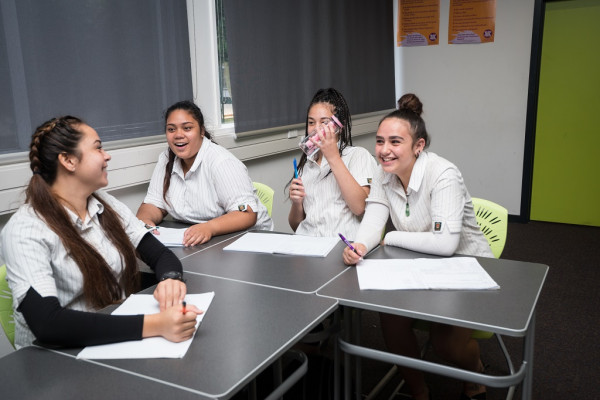Streaming - the unexamined wallpaper
18 months on from writing this blog about ending streaming, and in light of Kōkirihia - the plan to end streaming in schools – I've reflected back on these thoughts. In 2023 I am grateful and incredibly proud of the mahi involved with Kōkirihia that will ensure equity in education will exists for all tamariki in Aotearoa. This is something I am so passionate about.Equity thinking, equity by design and equity in practice are incredibly important approaches and framework to me personally, and to my colleagues at CORE Tātai Aho Rau who work also in this space.- Dr Pam O'Connell
The impact of streaming in education
When I was a social studies and maths teacher, I didn’t question why we streamed or ‘banded’ our learners. I just accepted this was the way it was – that it was best for learners to be sorted using a test that I did not even administer or mark, and probably did not even see the questions! I often taught the lower stream. That left me to decide what I could offer by way of resources and activities for these learners. I know I spent a great deal of time re-creating, cutting and pasting (literally!) activities that I thought my class would enjoy and be capable of achieving. Essentially, I was ‘dumbing down’ their curriculum with repetitive, mind-numbing activities; in effect, contributing to blunting opportunities for my learners and their sense of self-efficacy. I had never experienced the impact of being in “cabbage” maths or remedial classes.

Image copyright CORE Education, all rights reserved.
Professor Richard Elmore writes about the “unexamined wallpaper” on our staff room walls. He argues that most often we do not even ‘see’ the pattern or colour as we enter it each day. The streaming of learners based on their perceived abilities is certainly part of this wallpaper. We are so entrenched in this practice that we don’t see the patterns of harm it has caused for, what is now, generations of learners in Aotearoa New Zealand. This harm has been more fully described in Ending Streaming in Aotearoa, tagged with the impact of colonialism and illustrated by the voices of young people who articulate the trauma it has caused.
Even when I read Elmore’s 2002 article ‘Hard Questions About Practice’ as part of leading a national professional learning programme, I did not ask questions about streaming or the enduring grouping of learners. We knew about the importance of high expectations – studies emerging from research in South Auckland brought this to our attention in the teaching of literacy. The phrase is now everywhere in our system level policy documents but it is only over the last two years that streaming has come under scrutiny in terms of the explicit and tacit low expectations we may hold of the learners we work with.
OK, enough of beating myself up in public! Many of you will have a similar story. But we can take action now to influence change, reveal these patterns on the wall, get clarity on why streaming still exists in our communities and what forms and guises it now has.
I think the most critical question to ask of ourselves is who does this practice really benefit? It is one of Elmore’s hard questions about practice. It is also a question raised by indigenous researchers of traditional research methods, along with initiation, representation, legitimacy and accountability.
These hard questions place streaming at the heart of the current political, educational and public demand for equity.
- Who initiated streaming in our schools, when and why?
- Who has benefited from streaming?
- Who is represented in decision-making about structure and policies such as streaming?
- What legitimacy is given to the voices of our learners and their whānau in decision-making?
- Are educators accountable to their communities around streaming and its impact?
Defining streaming seems to be the first barrier to de-constructing streaming. Indeed, it is not straightforward. The first barrage of reactions to the streaming research released by Tokona Te Raki in April (2021) was to suggest this was all about secondary schooling, just as I described above, or the entry prerequisites in place for particular NCEA subjects. It is good to see the streaming questions ramping up now, prompting social media groups to consider if this is also about gifted education options that we design.
I also began to dig deeper with my primary colleagues on this. Yes, it is an issue here too. Those reading groups often matched to levels of reading texts do have the hallmarks of streaming, which I am beginning to define as ‘fixed and enduring groups that stigmatise learners’. The reading groups may be all sorts of imaginative names, but learners still know they are in the ‘bottom’ reading group and will likely stay there. Ask them.
Interestingly, the shining light in all of this has been the teaching of mathematics in primary schools, where substantive research has shown that mixed ability grouping, alongside what is termed “low floor, high ceiling” and culturally sustaining task design is bringing the results we want. Learners who are more engaged and challenged, build agency, self esteem and achieve at higher levels as a result.
There is really not a void after taking streaming away. There are well proven equity approaches that together will replace this practice. I am lucky to be part of an organisation that is working closely with Tokona Te Raki to support their call to action to end streaming in Aotearoa. We do not think this is a centre by centre, school by school, kura by kura response.
Together we advocate de-streaming as a community response – where you work with mana whenua, with whānau, with your learners and teachers to explore the whakapapa of streaming in your rohe, hear the voices of those that have experienced streaming and determine your critical pathway together. Kāhui Ako are well set now to take on this challenge as a community with mana whenua and whānau.
In terms of pedagogical responses there is not a single answer. We think it is a collection of practice kete. CORE started in a different place though, by looking at learning approaches in Te Ao Māori to guide our thinking. Knowing more about ‘tuakana teina’, ‘ako’ or ‘talanoa’ from your own community can shape the design for teaching and learning, flexible grouping and your role as kaiako – don’t assume you know this already. My experience working as an ally with iwi is that these kupu have rich tikanga and subtle differences depending on place.
As a final thought, I offer another idea that frees learners from the ability-group confines for learning that we impose, this is multi-age learning. Check out this reading about its advantages . We already have this structural response in our early years learning and in rural education. I think I need to start looking for some research on these learning environments in terms of normalising difference and supporting cognitive, social and emotional growth.
I am setting a challenge to you as readers to ask the hard questions about streaming in your learning community.
Have a look at our three free de-streaming resources. These are prompts for you to explore further.
If you would like to start a conversation about equity in your learning setting, that includes, looking at approaches to de-streaming, please contact me: pam.o’connell@core-ed.ac.nz
References
Elmore, R. (2002). Hard questions about practice in Education Leadership, Volume 59 | Number 8 p 22-25. ASCD.
Bishop, R. (2011). Freeing Ourselves. Sense Publishers: Boston.
Explore more content
Explore our wide range of education related podcasts and blogs, ranging from experts discussing Kaupapa Māori, Cultural capability and te reo Māori, Leadership, Pacific viewpoints, Digital and innovation, Inclusive learning and more.
